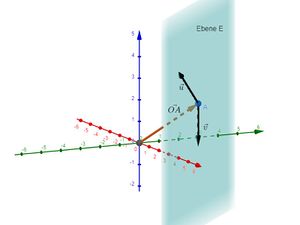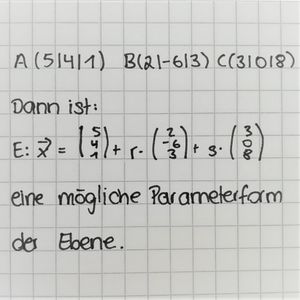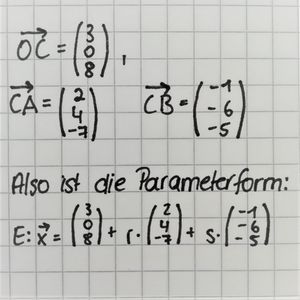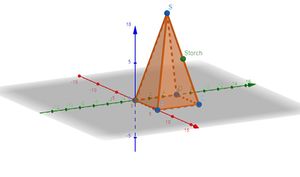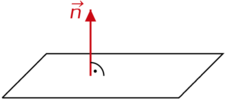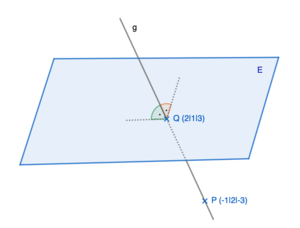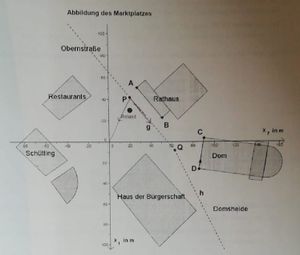|
|
| Zeile 378: |
Zeile 378: |
|
| |
|
| ===⭐Überführung der Parameterform in die Koordinatenform=== | | ===⭐Überführung der Parameterform in die Koordinatenform=== |
|
| |
| <br />{{Box | Beispiel: Von der Parameter- zur Koordinatenform einer Ebenengleichung |
| |
|
| |
| Wir suchen die Koordinatengleichung der Ebene <math>E\colon \vec{x} = \begin{pmatrix} 2 \\ 1 \\ 5 \end{pmatrix} + s \cdot \begin{pmatrix} 1 \\ -1 \\ 0 \end{pmatrix}+ t \cdot \begin{pmatrix} 1 \\ -3 \\ 4 \end{pmatrix}</math>.
| |
|
| |
| Ein Normalenvektor <math>\vec{n}</math> muss zu den Spannvektoren <math>\begin{pmatrix} 1 \\ -1 \\ 0 \end{pmatrix}</math> und <math>\begin{pmatrix} 1 \\ -3 \\ 4 \end{pmatrix}</math> orthogonal (senkrecht) sein, also ist <math>\begin{pmatrix} n_1 \\ n_2 \\ n_3 \end{pmatrix} \ast \begin{pmatrix} 1 \\ -1 \\ 0 \end{pmatrix}=0</math> und <math>\begin{pmatrix} n_1 \\ n_2 \\ n_3 \end{pmatrix} \ast \begin{pmatrix} 1 \\ -3 \\ 4 \end{pmatrix}=0</math>.
| |
|
| |
| Hieraus folgt:
| |
|
| |
| <div align="center"><math>\left\vert\begin{alignat}{7}
| |
| 1n_1 &&\; - \;&& 1n_2 &&\; + \;&& 0n_3 &&\; = \;&& 0 \\
| |
| 1n_1 &&\; - \;&& 3n_2 &&\; + \;&& 4n_3 &&\; = \;&& 0\\
| |
| \end{alignat}\right\vert</math></div>
| |
|
| |
| Für eine Berechnung per Hand formen wir die erste Gleichung um und erhaltet:
| |
|
| |
| <div align="center"><math>\begin{align}
| |
| & & 1n_1 - 1n_2 &= 0 & &\mid +1n_2\\
| |
| \Leftrightarrow & & n_1 &= n_2 & &\mid :(-24)\\
| |
| \end{align}</math></div>
| |
|
| |
| Durch Einsetzen der berechneten, von n_1 abhängigen Werte in die zweite Gleichung erhalten wir auch n_3 und damit den allgemeinen Normalenvektor in Abhängigkeit von <math>n_1</math>:
| |
|
| |
| <div align="center"><math> \vec{n} = \begin{pmatrix} n_1 \\ n_1 \\ \tfrac{1}{2} n_1 \end{pmatrix} </math></div>
| |
|
| |
| Für einen speziellen Normalenvektor wählen wir für <math>n_1</math> eine beliebige Zahl aus. Die wählen wir so, dass insgesamt ganzzahlige Zahlen raus kommen. Wenn <math>n_1 = 2</math> ist, dann folgt für <math>n_2 = 2</math> und für <math>n_3 = 1</math>.
| |
|
| |
| Daraus folgt für den speziellen Normalenvektor <math> \vec{n} = \begin{pmatrix} 2 \\ 2 \\ 1 \end{pmatrix} </math>
| |
|
| |
| Ansatz für die Koordinatengleichung: <math>E\colon 2x_1+2x_2+x_3=d</math>.
| |
|
| |
| Um <math>d</math> zu bestimmen, berechnet man das Skalarprodukt von <math>\begin{pmatrix} 2 \\ 2 \\ 1 \end{pmatrix}</math> mit <math>\vec{OA}=\begin{pmatrix} 2 \\ 1 \\ 5 \end{pmatrix}</math> und erhält <math>d=11</math>.
| |
|
| |
| Die Koordinatengleichung lautet somit: <math>E\colon 2x_1+2x_2+x_3=11</math>| Hervorhebung1}}
| |
|
| |
|
|
| |
|
| Zeile 423: |
Zeile 389: |
| Hieraus folgt das Gleichungssystem | | Hieraus folgt das Gleichungssystem |
|
| |
|
| <math>n_1+3n_2=0</math> | | <div align="center"><math>\left\vert\begin{alignat}{7} |
|
| |
|
| <math>-2n_1+n_2+3n_3=0</math>.
| | 1n_1 &&\; + \;&& 3n_2 &&\; + \;&& 0n_3 &&\; = \;&& 0 \\ |
| | |
| | {-}2n_1 &&\; + \;&& 1n_2 &&\; + \;&& 3n_3 &&\; = \;&& 0\\ |
| | |
| | \end{alignat}\right\vert</math></div> |
|
| |
|
| Wählt man z.B. <math>n_1=9</math> folgt durch Einsetzen in das Gleichungssystem und Umformen: <math>n_2=-3</math> und <math>n_3=7</math>. | | Wählt man z.B. <math>n_1=9</math> folgt durch Einsetzen in das Gleichungssystem und Umformen: <math>n_2=-3</math> und <math>n_3=7</math>. |

